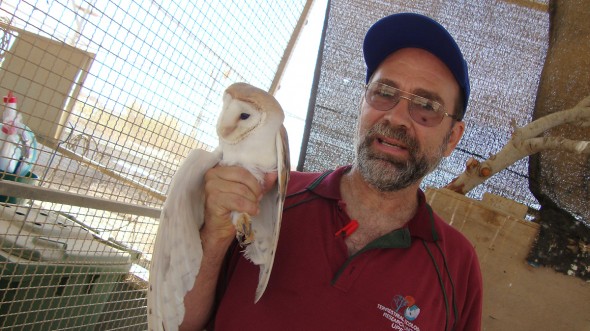Joel Brown keeps eye on predator-prey pairs

Biology professor Joel Brown studies the interactions between predator and prey, including the desert predators like the owl. “If you’re a gerbil trying to escape owls, you go into a shrub,” he says. “If you’re a snake, you stay in the shrub.”
Joel Brown is nuts about squirrels — his unique email address, squirrel@uic.edu, tells you that — but his current obsession is with rattlesnakes, rats and similar critters.
At a field station in Israel’s Negev Desert, he is studying the interaction of predator and prey.
In their Mideastern desert home, horned vipers feed on gerbils, while in the American West, sidewinder rattlesnakes go after kangaroo rats and pocket mice.
Brown noted that the two reptiles’ last common ancestor was 18 million years ago — yet over the last 6 million years, he said, “each has evolved near-identical adaptations to moving on sand, hunkering down to ambush rodents and other useful morphologies and behaviors.”
The biology professor brought predator-and-prey pairs from Arizona to Israel to compare with their Middle Eastern counterparts.
“It was snakes on a plane,” he said in joking reference to the 2006 Samuel L. Jackson movie.
The experiment enables Brown to “see what gerbils think of sidewinders and vice versa for kangaroo rats and horned vipers.
“Is a snake just a snake in their minds? Do they recognize and fear their own snake more than the novel snake?”
And the results?
“During ‘entry interviews’ the gerbils disliked either snake but exhibited a greater aversion to their own — the horned viper — than to the novel snake species,” Brown said.
This despite the fact that the rattler has one advantage over the viper, which is also a sidewinder: two heat-sensitive pits beneath the nose that afford the snake what amounts to night-vision goggles.
Brown calls this “a superpower.”
“The same happened for the kangaroo rats; they feared rattlesnakes more than the [novel] horned viper.”
After 30 days of watching the predator-prey pairs’ behavior, Brown and colleagues performed an “exit interview.”
“Gerbils still disliked both snakes but they revealed a newfound respect for the rattlesnake, fearing it slightly more than their native snake — they seemed to have learned about the new snake,” he said.
“Kangaroo rats retained their fear of rattlesnakes but exhibited much-reduced fear of the non-pit horned viper — they too had learned.”
Brown’s work is funded by the U.S.-Israel Binational Science Foundation. His long-time collaborator is Burt Kotler of Ben-Gurion University, with much of this work as part of the dissertation of UIC Ph.D. student Sonny Bleicher.
The biology prof also took note of another desert predator, the owl.
“If you’re a gerbil trying to escape owls, you go into a shrub,” he said. “If you’re a snake, you stay in the shrub.”
The upshot is that the snakes exploit the fear response of gerbils for owls, and vice versa.
“The owls make it easier for snakes to kill gerbils, and the snakes make it easier for owls to kill gerbils,” Brown said.
No wonder that for gerbils, “life is rough and short,” he said. The rodents’ life expectancy is only six months.
Back in this country, for the past five years Brown has been involved in cancer research with Robert Gatenby of the Moffitt Cancer Center in Tampa, Fla.
“We apply evolutionary game theory to understanding and treating cancer,” he said. “We’re trying to model cancer as an ecosystem in which a single-celled organism has its own evolutionary ecology.”
He’s also supervising 13 doctoral students in the lab.
“They’re studying everything from aardvarks to spotted genets [a long-tailed nocturnal mammal],” he said.
At one time or another, Brown himself has studied snow leopards in Nepal, rhinoceroses in Kenya and, this summer, octopi in Alaska, but he keeps coming back to squirrels.
“Everybody has a favorite animal — for some it’s dolphins, for others it’s primates — I like rodents,” he said.
“They’re out in the middle of the day, in your face. Everybody has a squirrel story; people relate to them easily.
“They’re accessible, they can teach us a lot, and they’re cute.”
Students enjoy hearing about more exotic creatures, he said.
“But the moment they leave the classroom, [those animals] are not real, not part of their world.
“When I start weaving squirrels in, students know what I’m talking about. And they don’t have to go to Kenya to see them.”
Brown spent most of his childhood in California, with four years in Zimbabwe, where his parents did medical missionary work.
He earned his undergraduate degree at Pomona College in California and his doctorate at the University of Arizona. His first teaching job, at UIC, began in 1987.
Brown and his wife, Jean Powlesland, live in Oak Park. They have two daughters: Miriam, 23, pursuing a master’s degree in school counseling at Purdue University, and Hannah, 20, a sophomore at Grinnell College in Iowa.
His wife is a nurse and developmental care specialist at the Medical Center, where she cares for premature babies.
“Our joke is that she works with small mammals as well,” Brown said.
